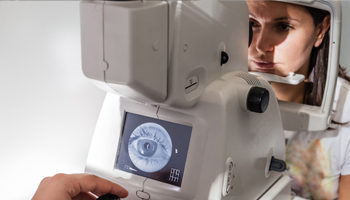HOW CAN WE HELP YOU? Call 1-800-TRY-CHOP
In This Section
Could Noninvasive Eye Imaging Safely Detect Elevated Intracranial Pressure, Without Surgery?

The findings:
Taking light-wave images of the retina through a process called optical coherence tomography (OCT) shows promise as a safe, noninvasive way to identify elevated intracranial pressure (ICP) in children with subacute conditions such as tumors, hydrocephalus, or head trauma.
Why it matters:
Even the most routine surgeries carry risks. The current methods for monitoring ICP are invasive and — as with any surgical procedure — can potentially cause problems such as bleeding, infections, or a leak of cerebrospinal fluid. Despite this, it’s still important for doctors to identify elevated ICP so that they can prevent any potential neurocognitive impairments or serious problems for children at risk. If OCT can show equal or better performance than conventional clinical measures, then it could very well be a safer effective alternative.
Who’s involved:
Researchers from the Children’s Hospital of Philadelphia Craniofacial Surgery Center and the division of Plastic Surgery, Ophthalmology, and Neurosurgery, and researchers from the Scheie Eye Institute and the department of Ophthalmology of the University of Pennsylvania’s Perelman Center for Advanced Medicine.
How they did it:
The researchers studied 79 children undergoing treatment at Children’s Hospital of Philadelphia. Forty of the children had craniosynostosis, five had hydrocephalus with suspected intracranial hypertension, and 34 were healthy and simply undergoing a minor procedure. The researchers compared the results of spectral-domain OCT with directly measured elevated ICP in all the children, and found that OCT produced 89 percent sensitivity and 62 percent specificity — a measure that outperformed other conventional clinical measures.
What’s next:
The current findings show that retina imaging has the potential to advance current treatment paradigms for measuring pressure in the skull. More research will be conducted to determine whether spectral-domain OCT of the peripapillary region is a viable tool for physicians.


